The culinary world is once again poised with exciting and innovative food trends. With a focus on sustainability, complex flavors, and health, the year ahead promises to be a gastronomic adventure like no other.
Mango-Black Bean Slider from Chowgirls Catering. Photo courtesy Lucas Botz
“Trends—what do they mean, and why? This is a question that is often asked and is always hard to answer, especially in our industry,” says Todd Annis (Cru Catering). “It depends on who you are and what position you hold.”
Plant-powered revolution
Veggie-centric dining continues to be a dominant force in the food industry, and 2024 will be no exception. According to a 2023 survey from Elohi Strategic Advisors, 69% of consumers of plant-based meat expect to eat more plant-based alternatives this year, with an additional 29% of these consumers expecting to eat the same amount.
Blossom Catering out of Napa, Calif. has developed a vegan foie gras made from cashews, which was served during a pop up event called M(Eat) Carnival this past October in Livermore, Calif. Photo courtesy Bryan Ngo
In 2024 we can expect to see an evolution of the plant-based movement through product and technological innovations.
Putting plants back in plant-based
Consumers and producers alike are looking to rely more heavily on traditional plant proteins (such as mushrooms, walnuts, tempeh, and legumes) in place of complex meat alternatives. Think pulled portobello sandwiches in place of pulled pork, black bean burgers, carrot tartare, and vegan foie gras made from cashews.
Carrot Tartare (roasted carrot and parsnip purée with carrot chicharron and cardamom-carrot vinaigrette) from Constellation Culinary Group. Photo courtesy Carolina Guzik
Where science meets culinary
Given the current popularity of Lessons in Chemistry (based on Bonnie Garmus’s best-selling book) on Apple+, where food and science collide, it’s no surprise that the culinary world is seeing tremendous technological advances in relation to plant-based products.
First up is precision fermentation, which is a technique that makes cheese with the help of yeast—no cow required.
Another alternative for producing food outside of traditional agriculture is cultured meat, which is cultivated from animal muscle and fat cells. In other words, products that taste like the original, but for which no animals had to be slaughtered. In 2023, two companies, UPSIDE Foods and GOOD Meat, received the first-ever regulatory approval to sell cultivated meat in the USA. This makes the United States the second country after Singapore to allow the sale of lab-grown meat.

Plant-based Chicken Katsu from Motif FoodWorks. Photo courtesy Motif FoodWorks
Another innovation on the market is Motif FoodWorks’s innovative ingredient advances to texture and taste. Their HEMAMI™ ingredient is comprised of a heme protein derived from cow muscle tissue (bovine myoglobin) which they make animal-free using precision fermentation. It provides the same umami, meaty flavor, and aroma of the real thing, but without the animal. Conversely, their APPETEX™ addresses the texture of meat by recreating connective tissue found in analog products that provide the springy chew and bite, which they recreate with plant fibers, specifically soybeans.

Breakfast Empanadas made with Motif FoodWorks’ plant-based protein. Photo courtesy Motif FoodWorks
“Operators wanted a product with a richer, meatier taste, flavor, and texture and to create an eating experience more akin to animal meats,” says Julia Dacri with Motif.
Regenerative agriculture
The focus is no longer just on the food that ends up on our plates, but rather on the way food is produced. 2024 will witness an even stronger emphasis on regenerative agriculture, where the focus is on restoring soil health, reducing the carbon footprint, and increasing biodiversity. Diners will find themselves more connected to their food sources as operators highlight their dedication to sustainable farming and ethical practices.
“There’s a real advantage to creating a cuisine, a menu where the vectors don’t all point at you, at the chef, but where the food that you’re eating points out to something larger,” said Chef Dan Barber (Blue Hill at Stone Barns) in season one of the Netflix series Chef’s Table. “When you are chasing after the best flavor, you’re chasing after the best ingredients; and when you’re chasing after the best ingredients, you’re in search of great farming. It’s not just about the dish, it’s about what the radish represents, it has to add up to something larger than a plate of food.

2024 will witness an even stronger emphasis on regenerative agriculture, where the focus is on restoring soil health, reducing the carbon footprint, and increasing biodiversity. Photo courtesy Lolagrace Photography
“Chefs play a huge role; we have this power now that we never had before. We can introduce change. We need to look at modernity and science when it comes to flavor. That is the future of really great cooking and really great farming. When you treat nature well, it gives you the gift of great food.”
Count on cacao
For a long time, cacao pulp (the white mucilage that surrounds cacao beans) was seen as a waste product from the process of chocolate making, but cacao-pulp is now getting new life.
The flavorful pulp is increasingly being used to make cacao pulp juice, a beverage that has a delightfully fruity taste. What makes cacao pulp juice even more trend-worthy is its health-giving properties. The beverage is naturally rich in fiber as well as antioxidants. Additionally, the pulp is being made into jellies and jams. The emergence of cacao fruit powders in 2023 also presents an opportunity for brands seeking a new sugar alternative without compromising on sweet, ambrosial flavor.
Bowl them over
Bowls have been popular for quite a while, but they’re poised to make a stronger standing in 2024.
Chicken Burrito Bowl from Restaurant Associates at Novartis Cambridge. Photo courtesy Tara Fitzpatrick
According to Unilever Food Services Future Menus report, bowls can help contribute to the low waste movement by making clever use of ingredients. Given how versatile bowls are, this incredibly popular menu item is a great dish format to use a multitude of ingredients in varying flavors and textures. Think of using parts of veggies that might otherwise hit the waste bin, like beet greens densely packed with nutrients or delicately flavored celery leaves. Trimmings of ahi tuna can be minced into the ever-popular spicy tuna for the perfect premium protein add-on to bowls.
Noodles will also be popular in bowls as consumers look for ways to dress up this food item with quality ingredients and tantalizing flavors.
Farm Vegetable Grain Bowl from Gate Gourmet. Photo courtesy Gate Gourmet

Poke bowl with tuna, seaweed, furikake steamed rice, and lotus crisps from Tuxedos and Tennis Shoes, a DSquared Hospitality Company. Photo courtesy NXT Creates
Heritage grains and ancient ingredients are also poised to make a comeback in the culinary world. Quinoa, amaranth, teff, and heritage wheat varieties are great additions to grain bowls, adding depth of flavor and a healthy twist to classic recipes.

Farro and Roasted Vegetable Bowl from Chef Cori Boudreaux. Photo courtesy NAM Future Menus 2023 Report
Caterers can also definitely tap into the bowl trend through creative action stations and build-your-own-bowl stations.
Sweet heat
Complex heat continues its evolution with global peppers taking off in every aisle—and the trend is only getting hotter. According to McCormick for Chefs, heat continues to push beyond the singularly spicy realm and takes off on a journey where heat and ingredient pairings come together to shape how heat is perceived and how long it lingers and finishes.
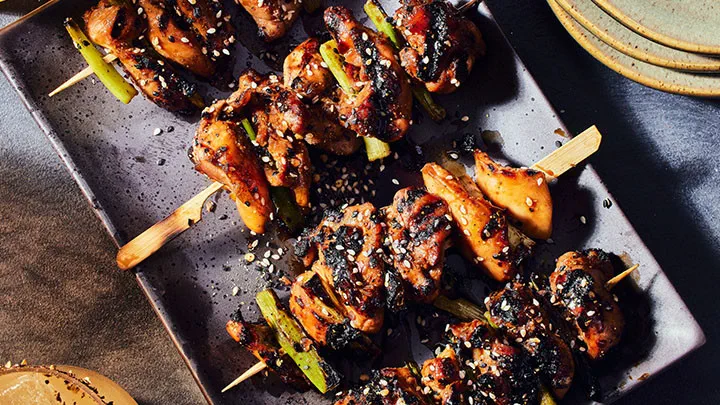
Sansho pepper yakitori with spicy furikake. Photo courtesy McCormick for Chefs
Specialty varieties like scorpion peppers, guajillo, or Hungarian Goathorn peppers are found fresh, whole, ground, or pickled, and a new wave of pepper-infused drinks, chili oils, and botana sauces are becoming increasingly popular, with the trend spreading to cheese. Even tajin is expanding from candies and cocktails to spicing up grocery store sushi, desserts, and more.
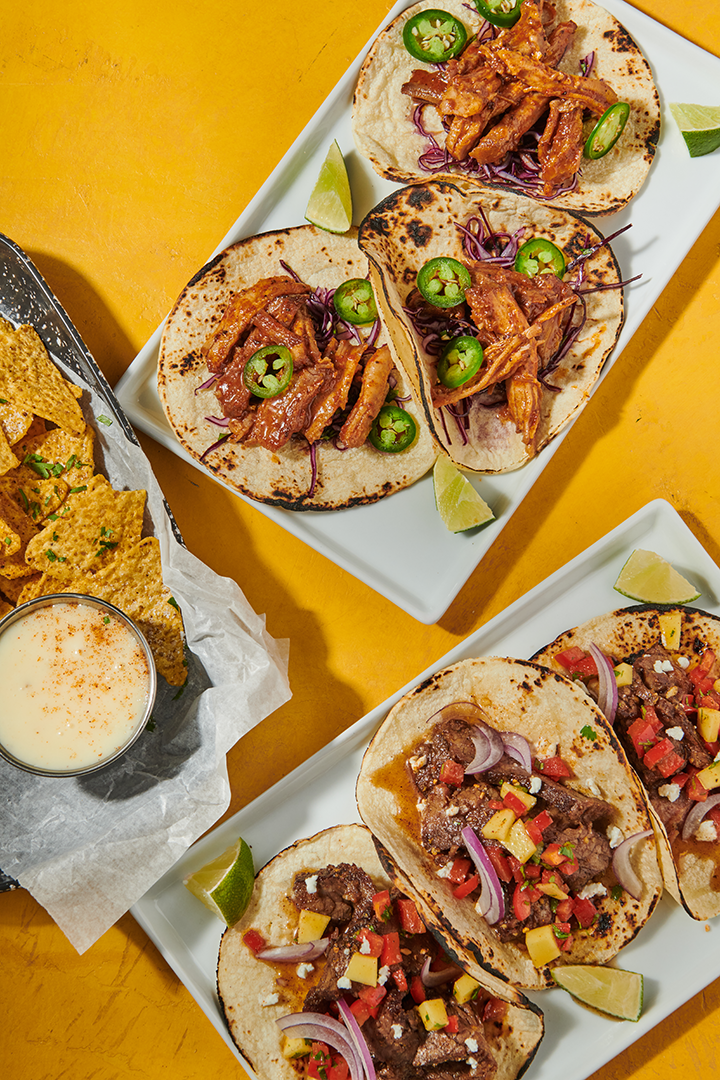
Cholula® Smoky Chipotle Carnitas and Carne Asada tacos. Photo courtesy McCormick for Chefs
2024 will also present a growing interest in foods defined by a spicy and sweet flavor combination known in some circles as “swicy.” While Americans love spicy foods, this “swicy” combination expands the appeal and approachability of hotter flavors. Hot honey, mango habanero, and other combinations are helping to create more complex, nuanced, and broadly appealing flavors across a range of applications.

These ice cream bars offer up a multi-sensory experience when it comes to the complexity of heat. Your first bite is the raspberry shell garnished with freeze-dried raspberries and a dusting of cayenne, followed by a luscious no-churn vanilla ice cream kissed with crushed red pepper and the sweet-heat of a Frank’s RedHot® and cayenne red pepper raspberry swirl. Photo courtesy McCormick for Chefs
Fin and fancy free
With tinned fish, oysters, and caviar taking off earlier this year, and plant-based seafood on the rise throughout 2023, it’s prime time for the fancy fish trend to really take off.
Watch out for carrots in place of lox, trumpet mushrooms for scallops, and the root vegetable konjac getting its moment in sushi rolls and poke bowls.
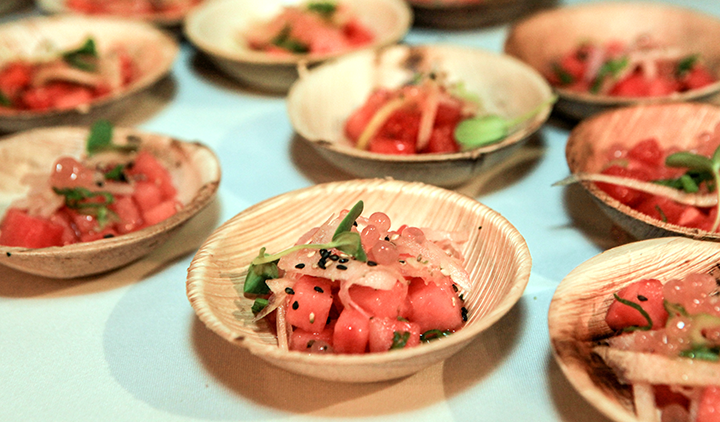
A Watermelon Poke Bite featuring watermelon poke marinated in yuzu and furikake on a nest of watermelon rind topped with watermelon “caviar.” Photo courtesy Buzz Orr Multimedia
Looking beyond product, seafood is also seeing an evolution in how it is sourced.
Today’s seafood farming, a practice known as aquaculture, is a far cry from what decades ago sparked visions of crowded tanks and dirty water. Today, over half of all seafood we eat in the U.S. is farm-raised, according to the Aquaculture Stewardship Council.

Whipped organic mashed potatoes loaded with Hope Creamery butter and local cream, topped with caviar and creme fraiche from Chowgirls Catering. Photo courtesy Amber Kispert
“I think the key with sustainable seafood, specifically farm-raised, is that consumers need to understand that well-managed farm-raised seafood tastes better. It is higher quality. There is a lot of science that goes into proper aquaculture and it shows in the taste and nutrition,” says Chef Andrew Gruel (Calico Fish House) in an article for ASC.
Function over fashion
Functional beverages are a growing opportunity, particularly as Gen Z and Millennials are more likely to want functional health benefits from their beverages. Consumers will seek out foods with functional benefits through ingredients like adaptogenic herbs, CBD-infused drinks, and stress-reducing nutrients, which will gain popularity as people prioritize holistic wellness through their diets.
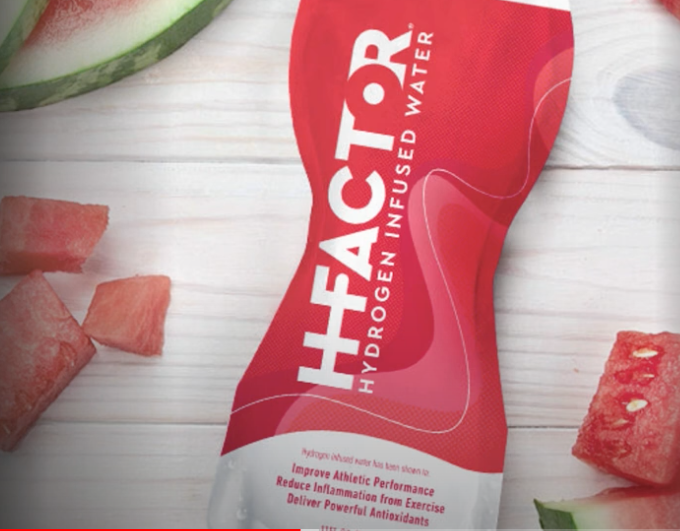
HFactor Hydrogen Water. Photo courtesy Datassential
According to Datassential, there is a 64% interest in the functional beverage market.
“It’s this idea that it has to do something for me, it can’t just taste good,” said Kelly Dykhuizen in Datassential’s Future Drinks webinar.

Functional beverages with turmeric support healthy liver function. Photo courtesy Datassential
This important segment includes natural wine and low-calorie/carb beer and cocktails, but also interesting takes on better-for-you drinks like functional sodas and detoxifying cocktails.
One such option is Hiyo, an effervescent “social tonic” that skips alcohol in favor of adaptogens, nootropics, and functional botanicals. In other words: herbs, mushrooms, roots, and other compounds that fight stress and promote healthy brain function.

Illicit Elixirs offers dopamine-producing beveages. Photo courtesy Datassential
Another is Javo’s energy lemonades, which boost energy while also providing the added benefit of mental focus.
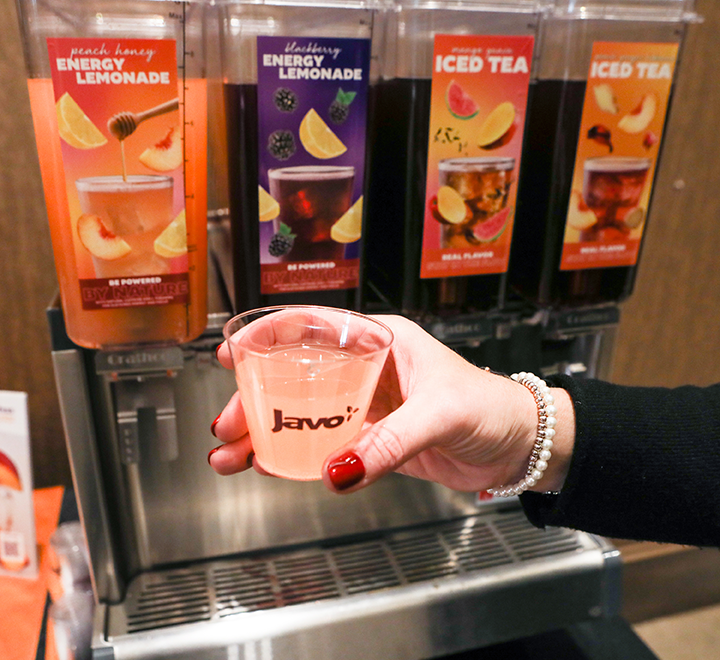
Javo‘s energy lemonades boost energy while also providing the added benefit of mental focus. Photos courtesy Buzz Orr Multimedia
A few other broad examples that are on the market are hydrogen-infused waters, mood boosting drinks that include such additives as ashwagandha, mushrooms, or turmeric, dopamine-boosting beverages, and CBD and THC beverages.
Macadamia’s magic moment
The macadamia nut market is growing fast as consumers turn to the nut, which boasts a bounty of nutritional benefits, as a healthy snack option.

Macadamia Mediterranean Muffins. Photo courtesy World Macadamia Organization
Celebrated for their rich creaminess, the nuts are versatile and used in everything from baking to savory sauces.

White Chip & Macadamia Nut Fudge. Photo courtesy Hershey Foodservice
“Macadamias are a unique, untapped whole food and have long been a well-loved tree nut with a positive health halo that product manufacturers and consumers enjoy as a specialty nut for everyday snacking as well as special occasions,” said Jillian Laing, chief executive officer, World Macadamia Nut Organization. “The timing could not be more fortuitous,” added Laing, who noted that macadamia supply increases are arriving just as key relevant food trends take hold worldwide. Among them:
- Functional nutrition. Macadamias are a “naturally functional food,” Laing said, easily meeting consumer desire for functional ingredients.
- Healthy fats. Consumer attitudes have evolved and now demand healthy fats in their diets, which macadamias readily provide.
- Carbs: fewer and better. Macadamias are an ideal choice for keto, low carb, and other similar meal plans.
- Nutrient density. A remarkable superfood, macadamias connect with consumers’ increased desire for nutrient density in their food choices.
- Flavor and texture. Macadamias’ rich, subtly sweet, and creamy flavor and satisfying crunch delight consumers who seek healthy, indulgent snacks.


